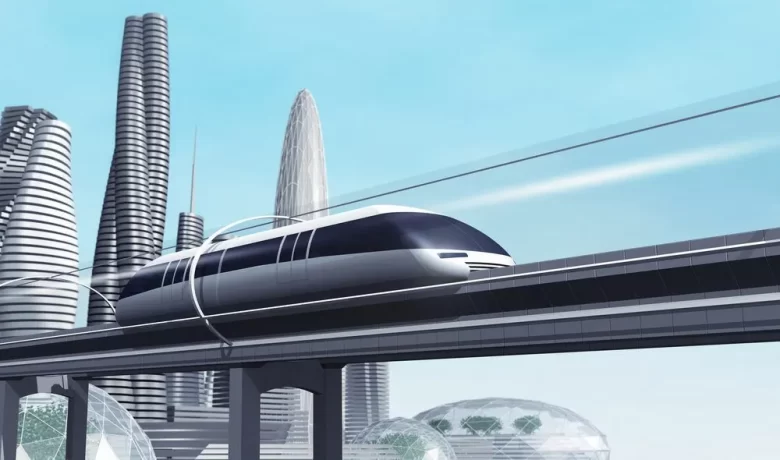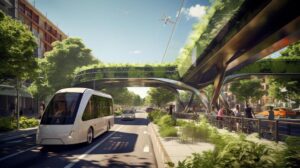Engineers, environmentalists, and futurologists are all fascinated by the idea of the Hyperloop. First proposed by Musk in 2013, the high-speed transportation system claims to be able to transport passengers and cargo at the speed of an airplane, using capsules in low-pressure tubes. As climate concerns grow and air travel remains one of the world’s largest sources of carbon emissions, the concept of eco-friendly alternatives is gaining traction. Is it possible for the Hyperloop to effectively serve as an alternative to airplanes for medium- to long-distance travel?
Is the Hyperloop merely a futuristic concept? In this article, we explore the green technology behind the Hyperloop, its environmental benefits, its practical limitations, and whether it has the potential to become a popular form of transportation. If the Hyperloop successfully faces the challenges that lie ahead, it has the potential to transform sustainable travel from a technological innovation to a global reality.
How Does a Hyperloop Work? What Is It?
Hyperloop is a proposed transportation system in which capsules travel through nearly vacuum tubes at speeds of 700 miles per hour. These pods use magnetic levitation or air bearings to significantly reduce friction. The low-pressure atmosphere allows the pod to move with less resistance, allowing for greater speed and energy efficiency. Linear electric motors typically provide propulsion forces. Unlike airplanes that rely on kerosene, the Hyperloop could run entirely on renewable energy. Such an option would reduce the amount of pollutants emitted during flight. The streamlined station design also allows for low noise and high boarding speeds.
Environmental Benefits of Air Travel:
Air travel accounts for about 2.5% of global carbon emissions, and this percentage is expected to rise. A greener option is the Hyperloop. Because the system could be powered by solar, wind, or other renewable energy sources, its carbon emissions could be close to zero. This option also eliminates the need to build airport infrastructure, which requires a lot of land and energy. The Hyperloop system is designed to minimize its environmental impact during construction and operation. Hyperloop produces zero emissions during operation and, if deployed on a large scale, could become one of the cleanest public transportation systems in the world.
Speed and Efficiency Compared to Airplanes:
Hyperloop advocates claim that over certain distances, particularly between cities that are 300 to 600 miles apart, the technology could offer speeds that are comparable to or faster than commercial aviation. Airplanes have long takeoff, landing, and taxi times, but a Hyperloop system could provide point-to-point transportation with far fewer boarding procedures. The study suggests that, depending on the flight, the total time passengers spend in traffic could be reduced. Because the Hyperloop system is automated and computer-controlled, human error is reduced, scheduling is improved, and speeds are kept consistent. For densely populated areas where flying is already the norm, this efficiency could change the way people travel.
Financial and Infrastructure Issues:
Despite the enormous potential of Hyperloop systems, there are still major infrastructure challenges to building a practical Hyperloop system. The costs of land acquisition, tunneling, pipeline construction, and system maintenance are very high. Unlike aircraft, which only require an airport and airspace, the Hyperloop requires a constant physical infrastructure to get from point A to point B. This means a large initial investment and potential delays due to technical and legal issues. Other challenges relate to land rights, safety regulations, and public acceptance. Per-passenger prices may be high initially, but proponents say that economies of scale could eventually bring costs down. Without addressing these obstacles, the feasibility of widespread implementation remains questionable.
Safety and Reliability Issues:
Safety is a major concern when it comes to air travel. Although aircraft have decades of proven performance and regulatory systems are in place, the Hyperloop is still in the experimental stages. There are still questions about how it will respond to emergencies such as natural disasters, system failures, and power outages. Some critics argue that closed pipelines could complicate rescue efforts after an accident. Hyperloop companies, on the other hand, are funding research to establish safety standards such as automated control systems, structural reinforcements, and emergency brakes. Despite the ongoing challenges, with appropriate engineering and regulation, the Hyperloop has the potential to surpass aviation in terms of safety standards.
Global Trials and Real-World Progress:
Several companies around the world are building prototypes of the Hyperloop. For example, Virgin Hyperloop operated a pod of people in the Nevada desert in 2020. India is conducting a feasibility study on a hyperloop route from Mumbai to Pune, which could reduce the three-hour journey time to 25 minutes. Other countries, notably the UAE and China, are considering the technology as part of their future mobility strategies. However, none of these measures have yet been commercially implemented. Most are still in the planning or testing phase. In the next decade, it will become clear whether these ambitious initiatives can evolve into an operational transportation system that competes with airplanes.
Hyperloop’s Contribution to a Sustainable Future:
If done right, the Hyperloop could be crucial to the development of a connected, sustainable transportation system. By replacing congested roads and short-haul flights with faster travel methods, we can reduce carbon emissions. The Hyperloop could revolutionize urban planning and lessen the environmental effects of commuting when paired with regional public transportation. As governments invest in greener infrastructure, this technology fits perfectly into future-proof policies. Its success, therefore, depends not only on the technology but also on political will, international cooperation, and societal support. Hyperloop certainly meets these criteria, because a sustainable future requires bold ideas.
Conclusion:
The idea of replacing planes with a hyperloop system may seem far-fetched now, but it is based on real technological promise and environmental needs. As green technology advances, so does our ability to create sustainable transport options. Most importantly, the Hyperloop significantly reduces carbon emissions, improves efficiency, and increases speed. Although the idea is still in its infancy and still faces significant challenges, it is one of the most promising developments in the quest for cleaner transport.
While it is certainly feasible to improve traffic on specific corridors, it may not be feasible to completely replace air traffic shortly. Investing in innovative technologies like the Hyperloop could be the key to a more sustainable future as cities expand and climate concerns increase. Only in the coming years will the reality of this utopian concept and metro travel become clear.
FAQs:
1. How is the Hyperloop different from a train?
Hyperloop is a high-speed transportation system that allows transport capsules to travel through low-pressure tubes at the same speed as an airplane. Unlike trains, it uses magnetic levitation technology and operates in near-vacuum conditions, significantly reducing friction.
2. Will the Hyperloop replace airplanes?
Hyperloop could be a faster and more environmentally friendly form of transportation, potentially replacing airplanes for short and medium distances. However, flying may still be more cost-effective for long international flights.
3. Is the Hyperloop bad for the environment?
Of course, the Hyperloop, especially if powered by renewable energy, could be excellent for the environment. Its operation involves zero emissions, making it a green alternative to fossil fuel-based transportation.
4. How safe is the Hyperloop compared to airplanes?
Hyperloop safety is still a topic that requires research and development. While it has the potential to be very safe thanks to automation and regulated settings, it does not yet have a proven track record in aviation.
5. When will the Hyperloop be operational?
There is no date set for the Hyperloop to become commercially available. While there are several trials and test tracks available, most systems are still in the development phase. It could take five to ten years before it is publicly available.




